Legislative Analyst's Office
The 2003-04 Budget Bill:
|
The Governor's budget proposes total spending in 2003-04 of $89.2 billion, including $62.8 billion from the state's General Fund and $26.5 billion from its special funds (see Figure 1). This total budget-year spending is significantly less than current-year spending—by $5.4 billion (5.7 percent). Proposed spending translates into $2,469 for every man, woman, and child in California, or $244 million per calendar day.
As discussed in "Part I" of this volume, the budget proposes a major realignment of state, county, and court program funding responsibilities. Under this plan, the state would shift responsibility to counties for roughly $8 billion of health, child care, and social services programs—and reduce by $300 million state General Fund support for trial courts. To offset these changes, the budget raises a net $8.2 billion from increased revenues from the personal income tax, sales and use tax, and cigarette tax, and provides this funding to counties and the courts via a new special fund. Because of this realignment proposal, the composition of spending between the General Fund and special funds will change significantly. For example, of total budget-year spending, General Fund spending accounts for slightly more than 70 percent. This compares to the average General Fund share of about 80 percent for the ten years ending in 2002-03.
Background. The General Fund is the main source of support for state programs, funding a wide variety of activities. For example, it is the major funding source for K-12 and higher education programs, health and social services programs, youth and adult correctional programs, and tax relief.
Proposed Spending. As shown in Figure 2, the Governor proposes General Fund spending of $62.8 billion for 2003-04. This is down $12.7 billion, or 16.8 percent, from the current-year's level. Under the proposal, most program areas would experience major General Fund reductions. It should be noted that the large declines in state spending shown for health and social services reflect both the realignment proposal and deep program-specific cuts (the Governor's specific proposals in individual program areas are discussed in the next section of this volume). Without the realignment proposal, the decline in total General Fund expenditures in 2003-04 would be 6 percent.
Background. Special funds are used to allocate certain tax revenues (such as gasoline and certain cigarette tax receipts) and various other income sources (including many licenses and fees) for specific functions or activities of government designated by law. In this way, they differ from General Fund revenues, which can be spent by the Legislature for any purpose. Historically, over one-half of the special funds revenues come from motor vehicle-related levies. Other major funding sources include the SUT and tobacco-related receipts.
Proposed Spending. In 2003-04, the Governor proposes special funds spending of $26.5 billion. This is a 37.8 percent increase from the current-year's proposed total of $19.2 billion. As indicated in Figure 3 (see next page), this sharp increase is due almost entirely to the additional special funds spending associated with the realignment proposal. This explains the dramatic 166 percent increase in local government subventions. Excluding the realignment proposal, special funds spending is proposed to decline by 4.7 percent.
It should be noted that the budget's special funds spending total for 2003-04 excludes expenditures of roughly $2.3 billion from the Local Public Safety Fund (LPSF). Such spending is also excluded from the current- and prior-year totals. Our view is that LPSF revenues are state tax revenues expended for public purposes. This treatment is consistent with how the budget treats other dedicated state funds, such as the Motor Vehicle License Fee Account (which, like the LPSF, is constitutionally dedicated to local governments) and the Cigarette and Tobacco Products Surtax Fund (Proposition 99), both of which the budget does include in its spending totals. However, although we believe that such spending does constitute state spending, we do not include it in our figures in order to facilitate comparisons with the budget's figures.
Figure 4 shows how state spending has varied as a percentage of total California personal income (which is a broad indicator of the size of the state's economy). From 1993-94 through 2001-02, total state spending increased steadily as a share of personal income—from 7.1 percent to 8.5 percent. Growth in General Fund spending accounted for all of the increase, since special funds spending as a percentage of personal income actually declined—by 0.6 percentage points.
Since 2001-02, however, total state spending as a percentage of personal income has reversed direction, and is projected to drop to 7.3 percent in 2003-04. The decline in the ratio results from previously noted 2003-04 declines in combined General Fund and special funds spending, and our projection that personal income will resume moderate growth.
In addition to the $89.2 billion of proposed 2003-04 spending from the General Fund and special funds, the budget also proposes $50.6 billion in spending from federal funds and another $7.2 billion from bond proceeds. If expenditures from bond proceeds and federal funds are included in total state spending, proposed 2003-04 spending exceeds $147 billion.
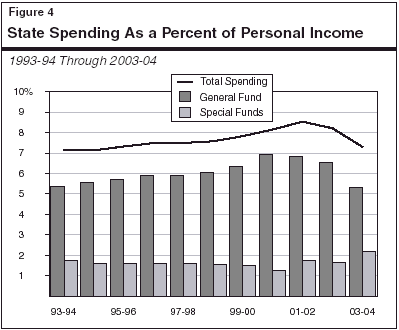
As noted above, about $50.6 billion in federal funds are proposed to be spent through the state budget in 2003-04. (This is about one-fourth of the roughly $200 billion in total federal funds allocated to California. The remaining three-fourths are allocated directly to local governments, businesses, or individuals within the state.) Federal funds in the budget consist almost exclusively of federal contributions to health and social services programs ($32.1 billion, or 64 percent of the total), education ($13 billion, or 26 percent), and transportation ($2.8 billion, or 6 percent).
Budgetary Treatment. Debt service on general obligation and lease revenue bonds is included in spending for the appropriate programmatic areas, as are direct expenditures on capital outlay projects from the General Fund or special funds. This gives a more complete picture of the current allocation of spending among different program areas. Spending from bond proceeds has not been included in the General Fund and special funds budget totals, however, because the spending of bond proceeds does not represent a current state cost. Instead, the cost of bond programs is reflected when the actual debt service payments (comprised of bond-related principle and interest payments) are made.For 2003-04, the budget proposes General Fund debt service expenditures of $2.4 billion, including $1.9 billion for general obligation bonds and $572 million for lease revenue bonds.
Although this way of treating bonds makes sense from a budgetary standpoint, tracking bond fund expenditures themselves still is useful as an indication of the actual volume of "brick and mortar" activities going on in a given year with respect to capital projects.
Spending of General Obligation Bond Proceeds. The budget estimates that the state will spend $7.2 billion in general obligation bond proceeds for capital projects in 2003-04. This compares to $14.7 billion in the current year and $3 billion in the prior year. About two-thirds of budget-year bond fund expenditures is for various local assistance projects such as K-12 school construction and local water quality improvements. The remaining one-third is dedicated for state-level capital outlay projects, primarily in the area of higher education.
Spending of Lease Revenue Bond Proceeds. In addition to general obligation bonds, the state also uses lease revenue bonds to finance the construction and renovation of capital facilities. Lease revenue bonds do not require voter approval, and their debt service is paid from annual lease payments made by state agencies (funded primarily through General Fund appropriations). For 2003-04, the budget proposes $1.8 billion in spending from lease revenue bond proceeds for such purposes as construction of state buildings, resources projects, and prison construction.
Background. In 1979, California's voters established a state appropriations limit (SAL) when they approved Proposition 4. The SAL places an "upper bound" on the amount of tax proceeds that the state can spend in any given year and grows annually by a population and cost-of-living factor. Most state appropriations are subject to the SAL; however, certain appropriations are exempt—including those for subventions to schools and local governments, capital outlay, and tax relief. If actual tax proceeds exceed the SAL over a two-year period, the excess must be divided among taxpayer rebates and Proposition 98 education funding.
Expenditures Projected to Be Below Limit. Due to the downturn in the state's economy and its adverse affects on the state's revenues, the budget's proposed expenditures are well below the SAL in both the current and budget years. This is in contrast to recent years when rapid spending growth eroded the "room" under the limit until the SAL was finally exceeded by $702 million in 1999-00.
In 2002-03, appropriations subject to the limit are $15 billion below the limit. In 2003-04, the administration's estimate of the gap shrinks to just under $6 billion. The smaller budget-year gap is partly due to the proposed $8.2 billion net increase in realignment-related taxes, and the fact that many of the budget reductions being proposed are in areas that are currently exempt from the limit. These include vehicle license fee subventions, and K-14 education apportionments.
Prior to looking at the programmatic details of the Governor's spending plan for 2003-04, it is first helpful to provide some perspective on state spending by looking at how the new plan's spending amounts compare to historical trends.
Figure 5 shows that total state spending increased moderately between 1993-94 and 1998-99, then jumped by nearly 33 percent between 1998-99 and 2001-02. In contrast, it is projected to fall 1.6 percent in the current year, and by a steeper 5.7 percent in 2003-04. Over the full ten-year period, total spending is up an estimated $37.6 billion (73 percent), an average annual rate of growth of 5.6 percent.
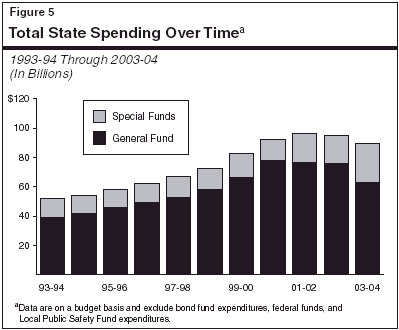
Figure 6 shows total state spending adjusted for inflation and population. It indicates that:
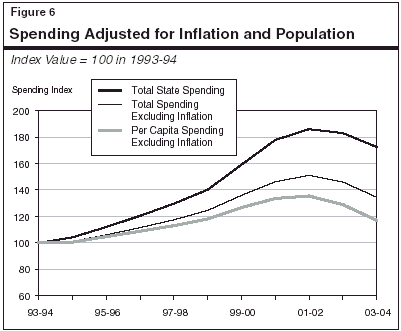
Figure 7 shows the allocation of the proposed $89.2 billion of total state spending in 2003-04 among the state's major program areas. Both General Fund and special funds expenditures are included in order to provide a meaningful comparison of state support among broad program categories, since special funds provide the bulk of the support in some areas (such as transportation).
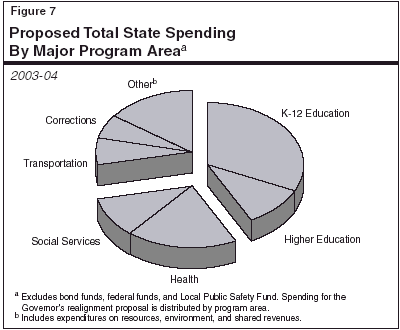
The figure shows that K-12 education receives the largest share of total spending—slightly less than one-third of the total. (It should also be noted that K-12 education receives additional funding from local sources.) When higher education is included, education's share rises to over 42 percent. Health and social services programs account for about 29 percent of proposed total spending, while transportation and corrections together account for roughly 13 percent. The "other" category (16 percent) includes general-purpose fiscal assistance provided to local governments in the form of shared revenues.
In order to gain perspective on how total state spending has changed for each broad programmatic area, Figure 8 (see next page) shows their proposed growth in the budget year compared to the average annual growth in these programs over the past ten years. For the second consecutive year, the Governor is proposing a budget with fewer expenditures than the current year. Total state spending is projected to decline significantly in the budget year (by 5.7 percent), which is in striking contrast to the average total growth over the past ten years (6.1 percent).
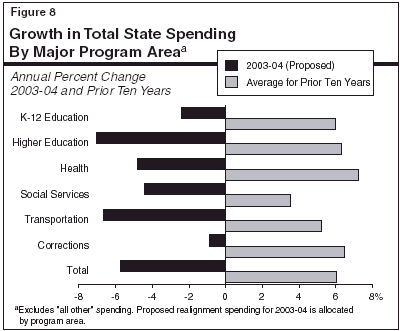
As Figure 8 illustrates, spending for every broad programmatic area is projected to decline during 2003-04, in contrast with average annual increases ranging from over 3.5 percent to nearly 7 percent for the prior decade. Higher education shows the largest decrease in state support during the budget year (7.1 percent), reflecting allocated and unallocated reductions at both the University of California and California State University. These reductions were largely offset in the budget proposal by assumed student fee increases. Transportation would decline by about 6.6 percent, health by 4.9 percent, and social services by 4.4 percent. K-12 education fares better (declining 2.4 percent), while corrections spending would drop by less than 1 percent.